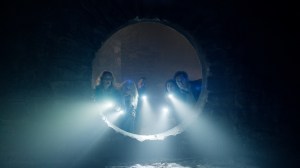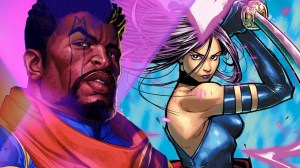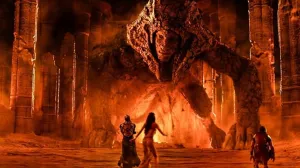
AMC pulled off the unimaginable by turning the post-apocalyptic zombie comic book The Walking Dead into one of the most well-known franchises on TV over the past decade, with the flagship series regularly setting viewership records and ultimately earning spinoff series and feature-film projects. That series largely blends horror with drama, but the first season of NOS4A2 proved to be a much more ambitious endeavor, as it brings together not just horror and drama, but also fantasy and sci-fi, making it one of the most unique genre experiences of last year. The first five episodes of Season Two continue to deliver viewers engaging surprises, though it is somewhat stifled by the nature of its time-jumping narrative and need for exposition, which the back half of the series can potentially resolve.
Videos by ComicBook.com
The first season concluded with Vic (Ashleigh Cummings) confronting Charlie Manx (Zachary Quinto) and escaping from his “Sleigh House,” thanks in part to Lou (Jonathan Langdon). With Charlie now “dead,” Vic has been able to move forward with her life over the course of eight years since that confrontation, which includes raising her son Wayne (Jason David). Much like her memories refuse to stay buried, so does Manx’s corpse, with Bing (Ólafur Darri Ólafsson) helping raise the ghoul from the dead to make Vic pay for what she had done.
The biggest hurdles that the series has to overcome is the jump forward in time and the changes to the status quo the viewers have to catch up with. While it’s exciting to see Vic and Charlie again, there’s a lot of exposition that the premiere has to account for, largely centering around establishing Lou as a character while also conveying how Vic’s trauma drove her to alcohol as a coping mechanism. In this regard, Lou’s bubbly personality, devotion to Vic, and obsession with comic books comes across as cartoonish, at times, though Langdon’s performance helps convey how you can’t help but love Lou, even if his excitability can be seen as grating. The broad nature of the character in the premiere is also replicated in the depictions of Vic’s alcoholism, which doesn’t entirely feel as genuine as it would if we had seen it evolve over nearly a decade, as opposed to viewers being thrown into the deep end of the addiction.
Another setback that the series suffers is that the second episode of the season sheds more light on Manx’s past and his connection to the Wraith. Many audiences would likely say that this backstory was unnecessary, thanks to how compelling the mystery surrounding his past was during the first season. From the audience’s perspective, there’s nothing inherently poor about the character’s history and how it’s explored, but with the first two episodes largely feeling as though they are catching the viewers up on history, it isn’t quite as gripping and takes the season a longer time to get the viewer invested.
Despite these initial setbacks, the show ultimately gets back into the groove of what made the first season so special, which is largely the unique tone and its mixture of genres. Rather than being a full-blown horror experience, we are also given whimsy and fantasy, while also earning straightforward interpersonal drama. What really comes across as the season progresses is the allegories for emotional and physical trauma, not just caused by fantastical encounters, but by any type of real-world trauma someone might suffer. While Vic wants nothing more than to shield her family from the horrors she suffered at the hands of Manx, it’s her mindset that burying those memories is more beneficial for her future that result in Lou and Wayne being completely unprepared for the past ultimately returning. Conversely, Manx essentially feeds on what Vic is repressing, only making him stronger. This makes Season Two just as compelling a tale about a soul-sucking ghoul aiming to settle a score as it makes for a compelling depiction of the toll any trauma can take on a victim over the course of their life.
The true triumph of the series is how showrunner Jami O’Brien has managed to embrace the spirit of Joe HIll’s novel, replicate it, yet still deliver unexpected narrative developments that readers won’t see coming. The first moments of the season premiere, for example, depicts the pint-sized terrors that populate Manx’s Christmasland, which mostly didn’t factor into the novel until its finale. Their organic incorporation changes the dynamic of the rest of the season, which will also surely change the impact of where readers know the narrative is heading. Similarly, a figure from Vic’s past shows up much more quickly in Season Two than they appeared in the book, adding new drama to her relationship with Charlie that was absent from encounters in the book. However, the spirit of the novel and some of its more memorable sequences are still embraced, appeasing devout fans and new audiences alike.
NOS4A2‘s strengths come from how it defies expectations at every turn, both in terms of what fans of the novel are expecting and for those audiences merely expecting a traditional horror story. While the dense opening episodes get the season off to a slow start, the series ultimately overcomes those setbacks to continue to prove itself as one of the most unique shows on televisions that refuses to be relegated to any one genre and instead crafts alchemy as bizarre and otherworldly as Charlie Manx himself.
Rating: 4 out of 5
Season Two of NOS4A2 premieres on AMC on Sunday, June 21st at 9 p.m. ET.








